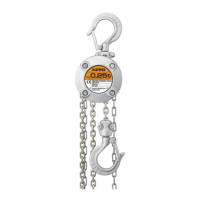8
Follow the instructions below when using the chain hoist.
Failure to comply with these instructions may result in death or severe injury:
- If any abnormality is detected during use, immediately stop using of the chain hoist, indicate "failure/repair in progress" and
request a competent person to perform maintenance and repair.
- When the manual force becomes excessive, stop operation immediately.
- Use sling appropriate for the weight and shape of a load. Improper slinging may result in an unsafe situation, such as the falling
of the lifted load.
- When any abnormality is observed during the operation, stop the operation immediately, indicate "FAILURE" and contact with
the maintenance engineers.
- When inspecting and repairing, be sure to indicate "INSPECTION" and carry out without lifting a load.
Do not use the chain hoist in the following manners.
Failure to comply with these instructions may result in death or severe injury:
- Do not operate the chain hoist as the hand chain is tangled or twisted.
- Do not expose the chain hoist to sparks from welding.
- Do not use an overload limiter for measuring the weight of the load.
- Do not apply a load to the hook tip or hook latch.
- Do not impede the lifted load or hand chain with other structures.
- If a load bounces up and down significantly when lowering the load, do not operate the chain hoist until the bouncing reduces.
Observe the following instructions when using the chain hoist.
Failure to comply with these instructions may result in death or severe injury:
- Unwind any twists in the load chain before lifting a load.
- If the load and hand chains are entangled or twisted, stop the operation immediately and reset the entangled or twisted chains.
- When lifting a load with two hoists, choose each hoist whose lifting capacity exceeds the load and operate the respective chain
hoist to keep the load lifted horizontal.
- There are risks of overheating of the braking system during prolonged lowering of loads.
If you are considering of the use under such condition, consult KITO.
Operation
(continued from the previous page)
Do not use the chain hoist in the following manners.
Failure to comply with these instructions may result in death or severe injury.
<Transportation/Move>
- Do not operate the chain hoist underneath the load or transport a load
over people. <Fig. I>
- Do not ride on a lifted load and do not use the chain hoist to support, lift,
or transport people. <Fig. J>
- Do not strike the stopper of the traversing rail or the structure with the
chain hoist or the trolley.
<Post-lifting Work>
- Do not execute welding or cutting work on a suspended steel plate.
- Do no use the load chain as the earth for welding work. <Fig. K>
- When repairing or disassembling, ensure that the chain hoist is placed down on the floor and
that only competent persons maintain the chain hoist.
- Ensure that the hand chain is pulled by a single person.
<Abnormality/failure>
- Do not use a damaged chain hoist or one generating abnormal sounds.
- Do not use the chain hoist if one of the following defects is found in the load chain.
Deformation, twists, kinks, flaws, cracks, adhesion of foreign matter, corrosion, and abnormal meshing.
- Heavy elongation or abrasion.
- Do not use the load chain hoist out of order or under repair.
I J
Prohibited
Mandatory
Prohibited
Mandatory
K

